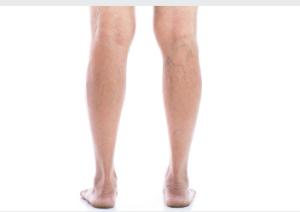Varicose veins form when your one-way valves that keep blood moving in the right direction are weak or damaged. As a result, sluggish blood backs up in the vein and pools, causing it to bulge and twist.
The condition is more common in women than men. Hormonal changes during puberty, pregnancy and menopause may increase your risk. Being overweight or obese also puts extra pressure on your veins.
Sclerotherapy
 Sclerotherapy is a minimally invasive treatment for varicose veins and spider veins. During this procedure, your doctor injects a liquid or foam solution that irritates and closes off small varicose and spider veins.
Sclerotherapy is a minimally invasive treatment for varicose veins and spider veins. During this procedure, your doctor injects a liquid or foam solution that irritates and closes off small varicose and spider veins.
The injected liquid or foam causes the walls of the enlarged vein to seal shut, directing blood to unaffected veins. This process can take two or more treatments every four weeks, depending on the varicose vein size or veins.
The doctor will first mark the central surface vein on your leg during sclerotherapy with ultrasound scanning. Next, a local anaesthetic will be injected into the skin, and a needle will be inserted into the vein, again using ultrasound scanning.
Aside from cosmetic concerns, untreated varicose veins can lead to pain and swelling in your legs. These problems can impact your quality of life and even increase your risk of developing Deep Vein Thrombosis (DVT), a severe condition in which a blood clot forms in a deep vein.
To avoid these complications, your doctor can recommend avoiding prolonged standing, elevating your legs regularly, and exercising. Also, try to maintain a healthy weight. These tips can help prevent varicose veins and improve your overall health. In addition, keeping your legs active and moving helps blood flow properly to the heart and reduces the pressure on the veins in your legs.
Endovenous Ablation
Endovenous ablation is an OdysseyVeinClinic Varicose Vein Cure Adelaide that uses ultrasound to find the veins causing pain and discomfort. It then uses radiofrequency or laser energy to close those veins off and redirect blood to healthy veins. This type of Varicose Vein treatment is a much more effective and less invasive alternative to surgery.
It’s a non-invasive procedure that doesn’t require much recovery time, and results are often seen within a week of the process. You will also likely notice a decrease in the appearance of your veins as time passes.
Once they have found it, your doctor will place the catheter in the vein. The catheter will have a small electrode at the end that emits high-frequency radio waves, which heat the tissue in the vein.
The radiofrequency energy creates a reaction in the vein wall, which causes it to collapse and cause sclerosis. It is a highly effective and safer varicose vein treatment with only mild side effects and fewer complications than other methods.
The procedure is not painful, and it usually takes about an hour. After the procedure, your doctor will give you a compression stocking for a few days to help minimise swelling and bruising.
Microphlebectomy
Varicose veins are enlarged, twisted, and bulging veins that can cause pain, itching, and swelling in the legs. They also indicate poor blood flow in the legs and an increased risk for clot formation (thrombophlebitis).
If you have medium to large varicose veins not eliminated by sclerotherapy or endovenous ablation, microphlebectomy can remove them from the skin’s surface. The veins will be removed segment by segment, leaving tiny incisions that heal with only minor scarring.
The OdysseyVeinClinic Varicose Vein Cure Adelaide procedure is performed in the office under local anesthesia. After the area is numb, the Interventional Radiologist will make tiny nicks in the skin and remove the damaged vein with a hook-like instrument.
Once the vein is removed, it is tied off so it can’t return to the skin’s surface. The skin is stitched and covered with bandages to heal like a regular cut.
Many patients report that the treatment is not painful and does not require any strong painkillers afterwards. It is because the needle that numbs the area is a magnificent pinprick and is rarely felt.
Another benefit of this varicose vein treatment is that it requires no major surgery, unlike other techniques. It allows you to return to work and your routine immediately after the procedure.
The procedure is performed on an outpatient basis and can be completed in less than an hour. It is typically done in conjunction with radiofrequency ablation to close off the feeder vein that supplies the surface varicose vein with blood. This way, the surrounding veins are preserved and removing the varicose vein is very effective.
Radiofrequency Ablation
RFA can help treat pain caused by varicose, spiders, and incompetent perforator veins. It can also treat vascular tumours or nodules that cause chronic pain.
Radiofrequency ablation is a safe and effective treatment method for varicose veins and can be performed in an outpatient setting with minimal downtime. In addition, it’s typically less expensive than vein stripping surgery and may result in more permanent relief from varicose veins.
